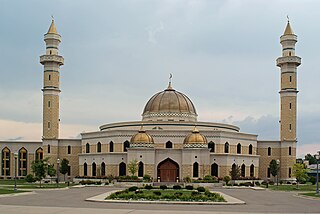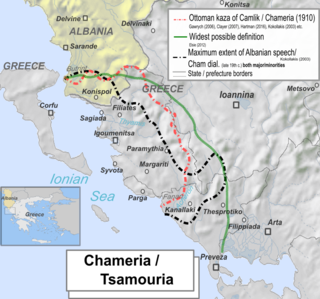Related Research Articles

Biddeford is a city in York County, Maine, United States. It is the principal commercial center of York County. Its population was 22,552 at the 2020 census. The twin cities of Saco and Biddeford include the resort communities of Biddeford Pool and Fortunes Rocks. The town is the site of the University of New England and the annual La Kermesse Franco-Americaine Festival. First visited by Europeans in 1616, it is the site of one of the earliest European settlements in the United States. It is home to Saint Joseph's Church, the tallest building in Maine.

Islam is the third largest religion in the United States (1%), behind Christianity (63%) and Judaism (2%), and equaling the shares of Buddhism and Hinduism. A 2017 study estimated that 1.1% of the population of the United States are Muslim. In 2017, twenty states, mostly in the South and Midwest, reported Islam to be the largest non-Christian religion. In 2020, the U.S. Religion Census found there to be 4.45 million Muslim Americans, or roughly 1.3% of the population.

Islam is the second largest religion in Australia. According to the 2021 Census in Australia, the combined number of people who self-identified as Muslims in Australia, from all forms of Islam, constituted 813,392 people, or 3.2% of the total Australian population. That total Muslim population makes Islam, in all its denominations and sects, the second largest religious grouping in Australia, after all denominations of Christianity.

Chameria is a term used today mostly by Albanians to refer to parts of the coastal region of Epirus in southern Albania and Greece, traditionally associated with the Albanian ethnic subgroup of the Chams. For a brief period (1909-1912), three kazas were combined by the Ottomans into an administrative district called Çamlak sancak. Apart from geographic and ethnographic usages, in contemporary times within Albania the toponym has also acquired irredentist connotations. During the interwar period, the toponym was in common use and the official name of the area above the Acheron river in all Greek state documents. Today it is obsolete in Greek, surviving in some old folk songs. Most of what is called Chameria is divided between parts of the Greek regional units of Thesprotia, Preveza, and Ioannina ; and the municipality of Konispol at the southernmost extremity of Albania. As the wider Greek toponyms Epirus has existed since antiquity and the narrower Thesprotia also reflects an ancient name, and given the negative sentiments towards Albanian irredentism, the term is not used by the locals on the Greek side of the border.
The most common religion in Albania is Islam, with the second-most-common religion being Christianity. There are also a number of irreligious Albanians. There are no official statistics regarding the number of practicing religious people per each religious group.

Islam in Greece is represented by two distinct communities; Muslims that have lived in Greece since the times of the Ottoman Empire and Muslim immigrants that began arriving in the last quarter of the 20th century, mainly in Athens and Thessaloniki. Muslims in Greece are mainly immigrants from The Middle East, other Balkan regions & North Africa.
The Islamic Center of Connecticut is a mosque located in Windsor, Connecticut serving the Muslim community of Hartford County.
There were 1,318,755 Muslims reported in the 2021 census in the Greater London area. In the 2021 census Office for National Statistics, the proportion of Muslims in London had risen to 15% of the population, making Islam the second largest religion in the city after Christianity.
Albanian Australians are residents of Australia who have Albanian heritage or descent; many are from Albania and North Macedonia but some are from Kosovo, Montenegro, Greece, Turkey, Bosnia and Italy. Albanian Australians are a geographically dispersed community; the largest concentrations are in the Melbourne suburb Dandenong and in the regional city Shepparton, both of which are in Victoria. The Albanian community has been present in Australia for a long period, and its presence in the country is unproblematic and peaceful.

The destruction of heritage sites associated with early Islam is an ongoing phenomenon that has occurred mainly in the Hejaz region of western Saudi Arabia, particularly around the two holiest cities of Islam, Mecca and Medina. The demolition has focused on mosques, burial sites, homes and historical locations associated with the Islamic prophet Muhammad, his companions, and many of the founding personalities of early Islamic history by the Saudi government. In Saudi Arabia, many of the demolitions have officially been part of the continued expansion of the Masjid al-Haram at Mecca and the Prophet's Mosque in Medina and their auxiliary service facilities in order to accommodate the ever-increasing number of Muslims performing the pilgrimage (hajj).

Bayt Tima was a Palestinian Arab village in the Gaza Subdistrict, located 21 kilometers (13 mi) northeast of Gaza and some 12 kilometers (7.5 mi) from the coastline. It was situated in flat terrain on the southern coastal plain of Palestine. Bayt Tima was depopulated during the 1948 Arab-Israeli War. Its population in 1945 was 1,060.
Jews have been living in Maine, a state in the northeastern United States, for 200 years, with significant Jewish communities in Bangor as early as the 1840s and in Portland since the 1880s. The arrival of Susman Abrams in 1785 was followed by a history of immigration and settlement that parallels the history of Jewish immigration to the United States.

Islamic monuments in Kosovo are commonly related with the Ottoman arrival in 1389, and respectively with their effective establishment in Kosovo in 1459. However, many historical evidences show that the first encounters of Islam with the Balkans happened well before the arrival of the Ottomans and their establishment in the Balkans. Because of its proximity to the centers of Islam, i.e., Middle East, the Byzantine Empire and parts of the Balkans, including the Albanian territories and Kosovo as well, were exposed to Islam as early as in the 8th century.

Kingston Pioneer Cemetery is a heritage-listed cemetery at Bega Road, Kingston, City of Logan, Queensland, Australia. It was built from 1896 to 1941. It was added to the Queensland Heritage Register on 26 May 2000.

McArthur Public Library is a public library in Biddeford, Maine. It opened in October 1863 as a department within Biddeford City Hall, and has been in its current location since 1902. It is one of the oldest tax-supported libraries in New England, and the oldest in the state of Maine.
Shanga is an archaeological site located in Pate Island off the eastern coast of Africa. The site covers about 15 hectares. Shanga was excavated during an eight-year period in which archaeologists examined Swahili origins. The archaeological evidence in the form of coins, pottery, glass and beads all suggest that a Swahili community inhabited the area during the eighth century. Evidence from the findings also indicates that the site was a Muslim trading community that had networks in Asia.
The Islamization of Albania occurred as a result of the Ottoman conquest of the region beginning in 1385. The Ottomans through their administration and military brought Islam to Albania through various policies and tax incentives, trade networks and transnational religious links. In the first few centuries of Ottoman rule, the spread of Islam in Albania was slow and mainly intensified during the seventeenth and eighteenth centuries due in part to greater Ottoman societal and military integration, geo-political factors and collapse of church structures. It was one of the most significant developments in Albanian history as Albanians in Albania went from being a largely Christian population to one that is mainly Sunni Muslim, while retaining significant ethnic Albanian Christian minorities in certain regions. The resulting situation where Sunni Islam was the largest faith in the Albanian ethnolinguistic area, but other faiths were also present in a regional patchwork, played a major influence in shaping the political development of Albania in the late Ottoman period. Apart from religious changes, conversion to Islam also brought about other social and cultural transformations that have shaped and influenced Albanians and Albanian culture.

The Mellah of Fez is the historic Jewish quarter (Mellah) of Fez, Morocco. It is located in Fes el-Jdid, the part of Fez which contains the Royal Palace, and is believed to date from the mid-15th century. While the district is no longer home to any significant Jewish population, it still contains a number of monuments and landmarks from the Jewish community's historical heritage in the city.

The Mareeba Mosque, officially known as the Mareeba and District Memorial Mosque, is a mosque located in Mareeba, a rural town in Queensland, Australia. The building contains a minaret, and an adjacent hall used for community functions that houses the library and visitors room. Associated with the Albanian Australian community, the mosque is owned by and the centre of the Albanian Australian Moslem Society.
References
- ↑ Irish Collins, Kate (September 9, 2010). "Biddeford site of early 'mosque'". Keep ME Current. Archived from the original on October 17, 2010. Retrieved August 23, 2012.
- ↑ "Largest Albanian communities in Maine". ZipAtlas and U.S. Census Bureau . Retrieved May 9, 2024.